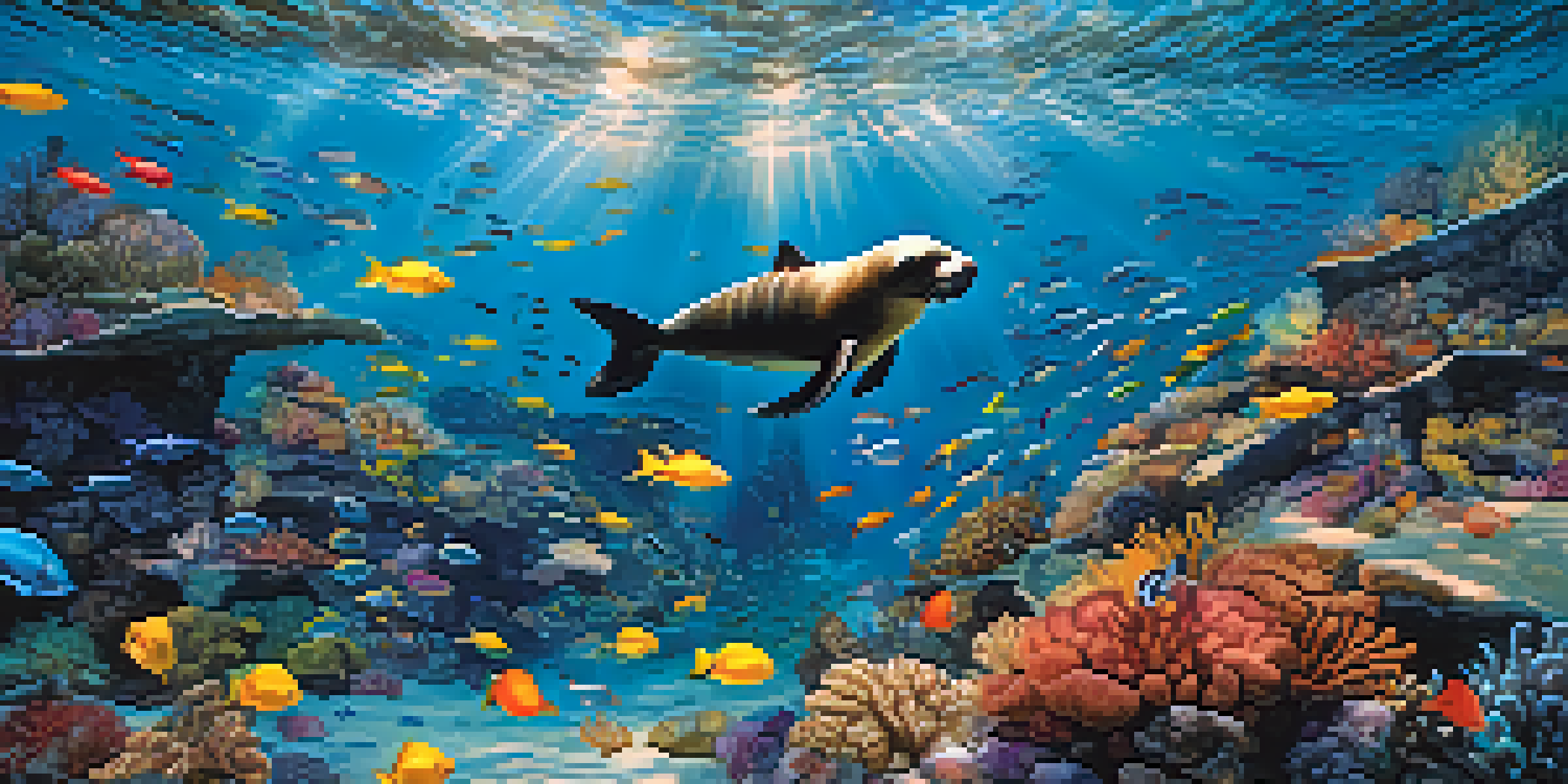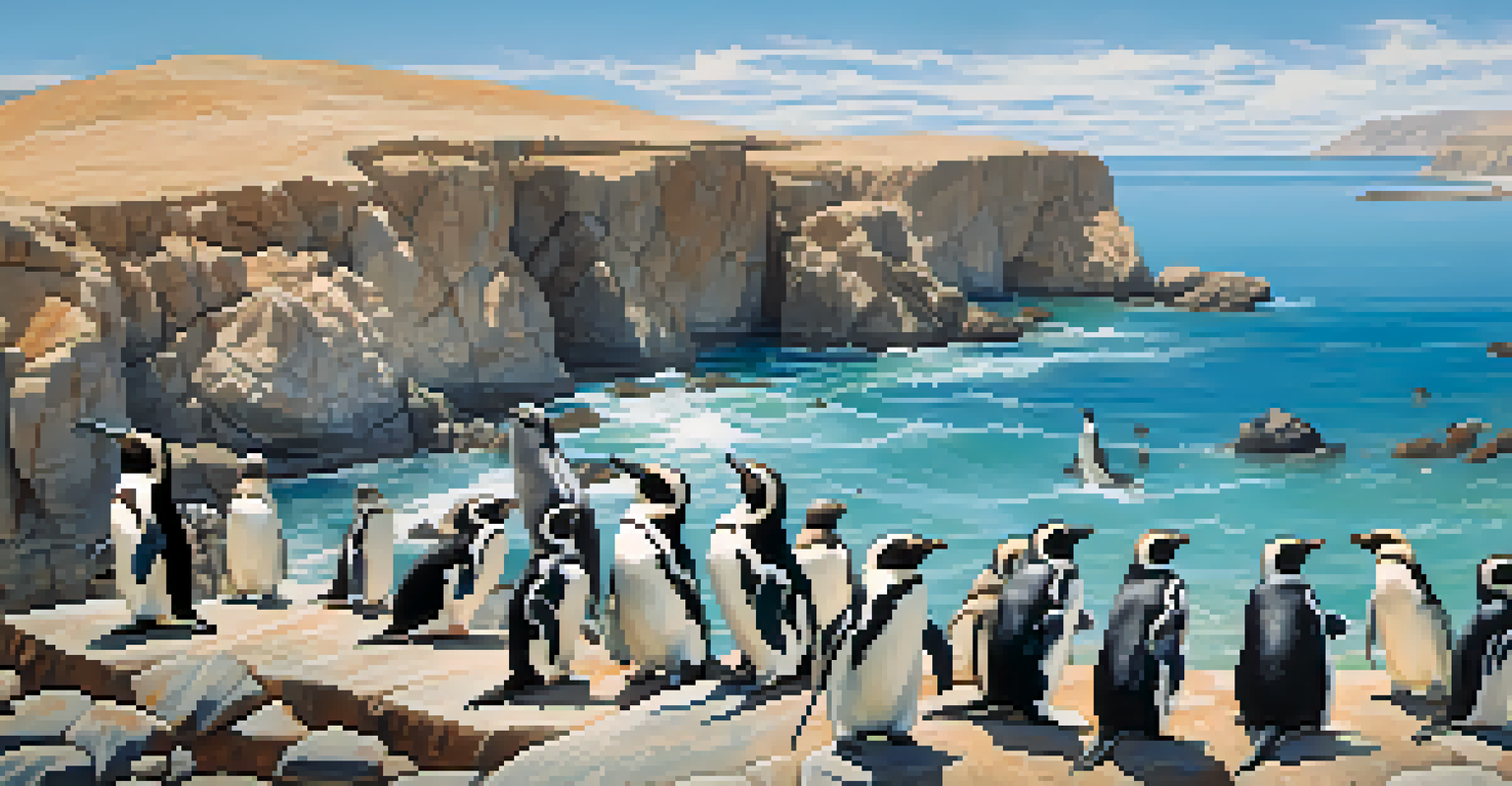Peru's Marine Biodiversity: Oceans teeming with Life

Peru's Unique Position in Marine Biodiversity
Peru sits at a crossroads of rich marine ecosystems, influenced by both the cold Humboldt Current and the warm waters of the Pacific. This unique geographic location creates a diverse range of habitats, from rocky coastlines to deep oceanic trenches. As a result, Peru's waters are home to an astounding variety of species, making it one of the most biodiverse marine regions in the world.
The sea, once it casts its spell, holds one in its net of wonder forever.
The Humboldt Current, in particular, plays a vital role in supporting marine life. It brings nutrient-rich waters that fuel the growth of phytoplankton, the foundation of the marine food web. Consequently, this nutrient influx attracts a multitude of fish species, marine mammals, and seabirds, creating a vibrant ecosystem teeming with life.
Understanding Peru's marine biodiversity also highlights the interconnectedness of ocean health and climate. Changes in ocean currents and temperatures can impact the distribution and abundance of marine species, reminding us of our role in protecting these delicate ecosystems.
Diverse Marine Species in Peru's Oceans
In Peru's waters, you'll find a dazzling array of marine species, including over 2,000 types of fish, 400 species of mollusks, and numerous marine mammals. Iconic species such as the endangered Humboldt penguin and the majestic sea lion can often be spotted along the coast. Moreover, the waters are also home to whales, including the humpback and the blue whale, which migrate through these regions.

Coral reefs, often overlooked, also play a crucial role in supporting marine biodiversity. Although Peru's reefs are not as extensive as those found in the Caribbean, they still provide essential habitats for countless marine organisms. The intricate relationships within these ecosystems are vital for maintaining the balance of marine life.
Peru's Rich Marine Biodiversity
Peru's unique geographic location fosters an incredible diversity of marine species, supported by the nutrient-rich Humboldt Current.
The diversity doesn’t stop at the surface; deep-sea creatures such as the enigmatic giant squid and bioluminescent organisms thrive in the dark depths of Peru's oceans. These unique species contribute to the overall biodiversity and highlight the importance of exploring and conserving these underwater realms.
The Importance of Marine Protected Areas
Marine Protected Areas (MPAs) are essential for conserving Peru's rich marine biodiversity. By establishing these zones, the government aims to safeguard critical habitats and ensure sustainable fishing practices. MPAs provide a refuge for many species, allowing them to thrive and reproduce without the pressures of human activity.
We won't have a society if we destroy the environment.
One notable example is the Paracas National Reserve, which protects marine life and promotes eco-tourism. Visitors can witness the stunning variety of wildlife, from colorful fish to playful sea lions, all while supporting conservation efforts. This balance between tourism and preservation is crucial for the long-term health of the marine environment.
However, effective management of MPAs requires ongoing commitment and collaboration among local communities, scientists, and policymakers. Engaging stakeholders ensures that conservation strategies are not only effective but also equitable, benefiting both marine ecosystems and the communities that rely on them.
Threats to Peru's Marine Biodiversity
Despite its richness, Peru's marine biodiversity faces numerous threats. Overfishing remains one of the most significant challenges, depleting fish stocks and disrupting the delicate balance of marine ecosystems. Unsustainable fishing practices, such as trawling, can also damage habitats and reduce biodiversity.
Pollution from land-based sources is another pressing concern. Agricultural runoff, plastic waste, and industrial discharges can contaminate the waters, harming marine life and the health of coastal communities. The impact of climate change, including rising sea temperatures and ocean acidification, further exacerbates these challenges, putting additional stress on marine ecosystems.
Threats to Marine Ecosystems
Overfishing, pollution, and climate change pose significant threats to the delicate balance of Peru's marine biodiversity.
Addressing these threats requires a multi-faceted approach, including stricter regulations, community engagement, and education. By raising awareness about the importance of marine biodiversity, we can foster a culture of conservation and stewardship among both locals and visitors.
Traditional Fishing Practices and Sustainability
Peru's coastal communities have long relied on fishing for their livelihoods, often using traditional methods that promote sustainability. These practices, such as selective fishing and seasonal closures, help maintain fish populations and minimize environmental impacts. The knowledge passed down through generations is invaluable in ensuring the health of marine ecosystems.
In recent years, there has been a growing movement to integrate traditional fishing practices with modern sustainability goals. Initiatives that empower local fishermen to adopt eco-friendly methods not only preserve biodiversity but also enhance their economic resilience. This holistic approach demonstrates the importance of blending cultural heritage with contemporary conservation efforts.
Promoting sustainable fishing practices also helps raise awareness about the importance of marine biodiversity among local communities. As fishermen become stewards of the ocean, they play a crucial role in protecting Peru's rich marine life for future generations.
The Role of Research in Marine Conservation
Scientific research is essential for understanding and protecting Peru's marine biodiversity. Researchers study various aspects of marine ecosystems, from species distribution to the impacts of climate change. This knowledge informs conservation strategies and helps guide policy decisions for sustainable management of marine resources.
Collaborative efforts between scientists, local communities, and government agencies have led to significant advancements in marine conservation. By sharing knowledge and resources, stakeholders can develop effective strategies that address the unique challenges faced by Peru's marine ecosystems. These partnerships are vital for fostering a culture of conservation.
Sustainable Fishing Practices
Integrating traditional fishing methods with modern sustainability goals can help conserve marine life while supporting local communities.
Moreover, citizen science initiatives are gaining traction, allowing everyday people to contribute to marine research. Engaging the public in monitoring marine life not only raises awareness but also empowers communities to take an active role in conservation efforts.
Looking Ahead: The Future of Peru's Marine Biodiversity
The future of Peru's marine biodiversity depends on collective efforts to address the challenges it faces. By prioritizing conservation, sustainable practices, and scientific research, we can ensure that these vibrant ecosystems endure for generations to come. Education and awareness are key to inspiring action and fostering a sense of responsibility towards our oceans.
Local communities, governments, and organizations must continue collaborating to develop innovative solutions that balance economic needs with environmental protection. Supporting eco-tourism, sustainable fishing, and marine research can create a sustainable future that benefits both people and nature.

Ultimately, the health of Peru's oceans reflects our global commitment to preserving marine biodiversity. As stewards of the environment, we all have a role to play in safeguarding these precious ecosystems and ensuring a thriving underwater world.